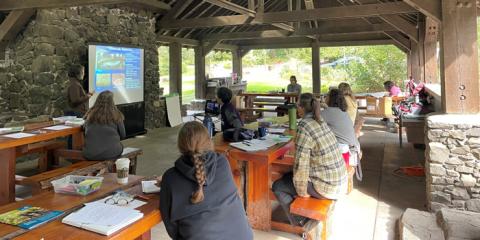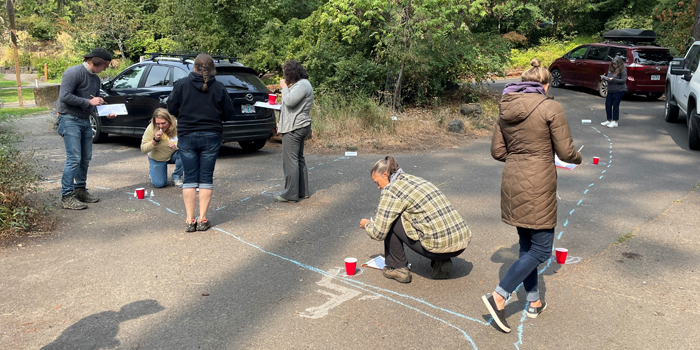The other “Fish to Fry”
October 11, 2022
When you Google the term “fish to fry,” you’re rewarded with multiple recipes for creating the perfect fried-fish dinner, plus the idiom “other fish to fry,” defined as other matters to deal with.
It’s harder to find a description of Fish Eggs to Fry, the Oregon Department of Fish and Wildlife’s (ODFW) amazing program, often simply called “Fish to Fry,” that gives students in classrooms from kindergarten through high school a way to observe the biology of salmon, steelhead or trout – and participate in these species’ life cycle – in a hands-on way. Through ODFW’s Salmon and Trout Enhancement Program (STEP), Fish Eggs to Fry brings salmon or trout eggs into more than 700 Oregon classrooms each year for students to observe, raise and then release while learning about some of our state’s most iconic species.
Last month, teachers from Lane County gathered at Hendricks Park in Eugene to attend a workshop put on by Oregon Natural Resources Education Program in partnership with OFRI and ODFW, to learn how to participate in the Fish Eggs to Fry program and how to support student learning with related curriculum resources.
At the workshop, STEP biologists from ODFW provided some expert advice on salmon and trout species in Oregon, including their life cycles and habitat needs. They discussed the economic and environmental importance of salmon and the challenges they face in the wild. Teachers also received OFRI K-12 publications to support their teaching about forests, fish and wildlife.

After hearing about the biology of the fish, teachers learned the process for setting up their classroom aquarium and getting the eggs. Once they receive the eggs, it’s important that students monitor the temperature of the water in the aquarium and also make sure it stays clean.
Data sheets are available so students can take daily temperature readings and calculate how long it will be until the fish are mature. With the classroom aquarium, students learn about the life history of the fish as they observe the eggs hatching and transforming into “sac fry” before becoming tiny salmon. The class then takes a field trip to a local creek, stream or river to learn about fish habitat and set free the one-inch-long fish they helped raise.
Teachers gave the workshop high marks, and indicated that they learned a lot of information they could apply to their classroom. All the teachers who attended the workshop planned to get fish eggs and participate in the program.
Fish, especially salmon and steelhead, are synonymous with Oregon. It’s nice to know that OFRI is playing a part in helping students learn about these important species that spend crucial parts of their life cycles in Oregon forests.
Norie Dimeo-Ediger
Director of K-12 Education Programs
